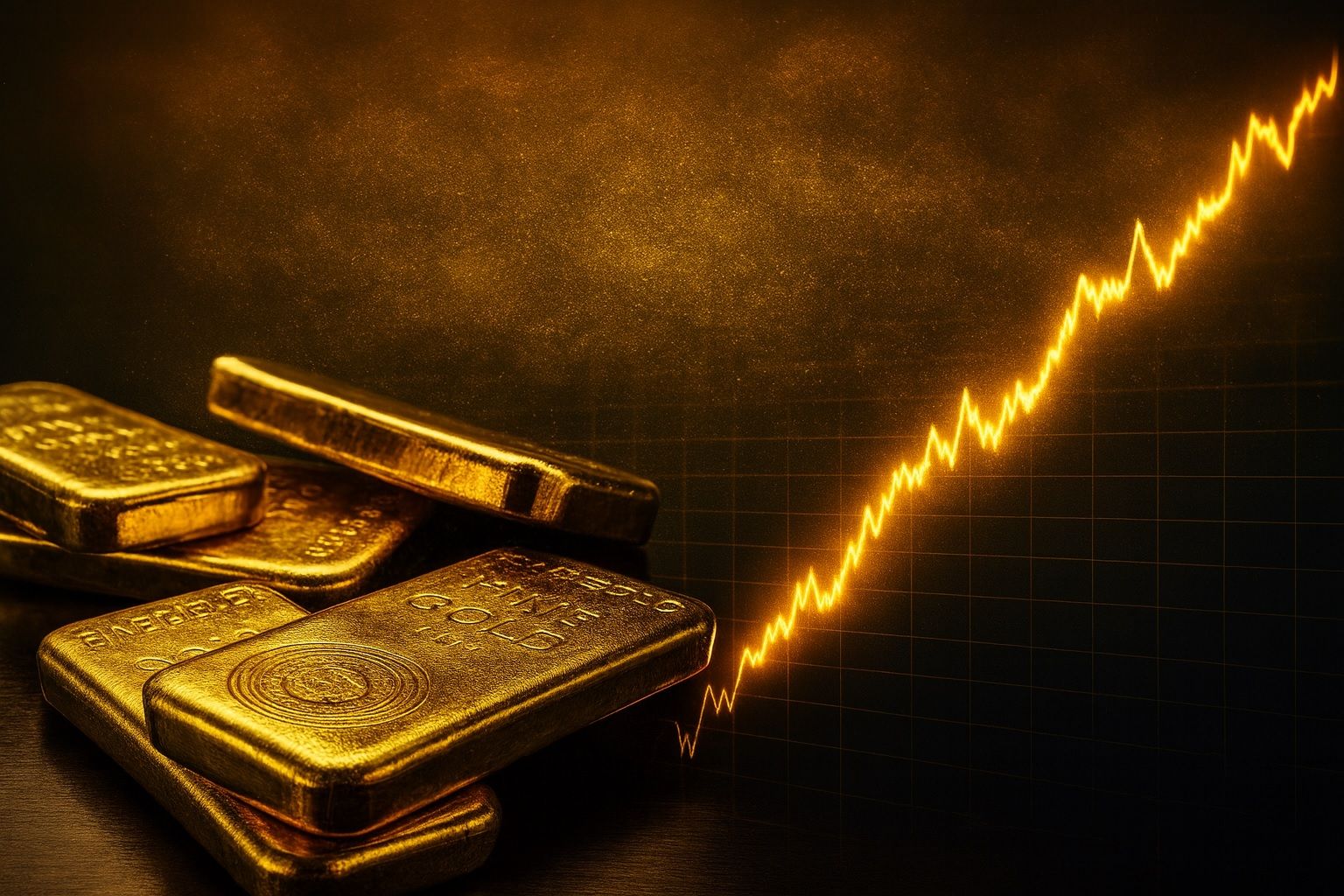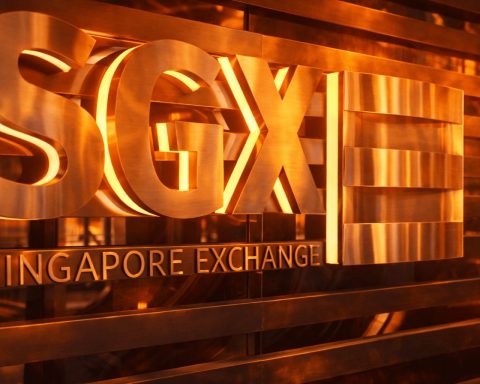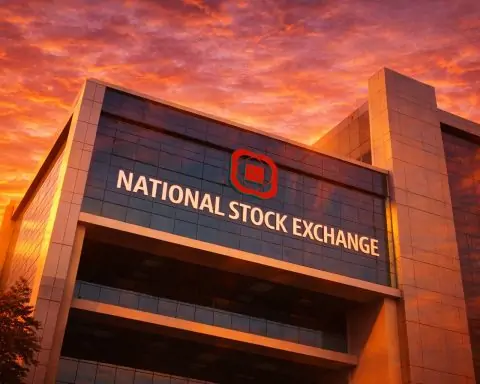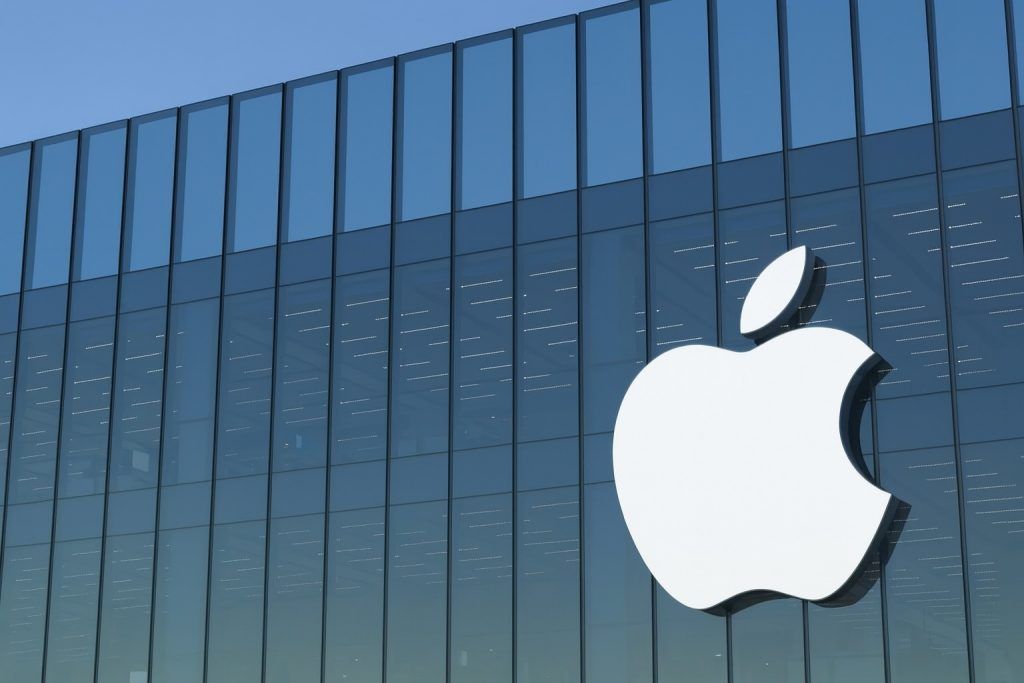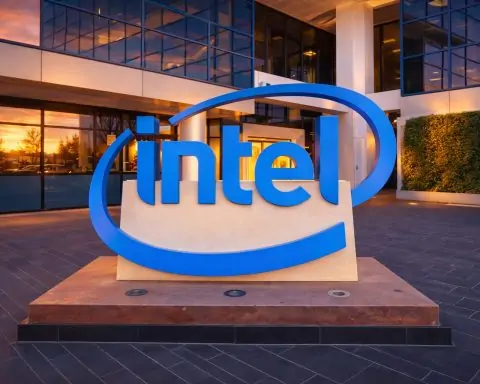- Record highs: Gold prices briefly shattered all-time peaks this week, hitting about $4,381/oz on Oct 20 and trading near $4,300/oz on Oct 21 [1] [2]. The metal is up roughly 60–63% in 2025, far outpacing stocks and other assets [3] [4].
- Driving forces: The rally is fueled by expectations of imminent Fed rate cuts, stubborn inflation and a weak dollar, plus heightened geopolitical and economic uncertainty (Middle East tensions, U.S. debt worries, trade frictions, etc.) [5] [6]. In this “safe-haven” climate, investors are flocking to gold.
- Surging demand: Central banks and funds are piling in. Nations from China, India, Turkey and beyond are stockpiling gold reserves at a record pace to diversify away from the dollar [7]. At the same time, ETF and fund inflows have been “insatiable” – about $64 billion has poured into gold-backed ETFs so far in 2025 (with ~$17.3B alone in September) [8] [9] – a pace seen as unprecedented.
- Local gold rush: In New York City’s Diamond District, jewelers report a feeding frenzy. As the NYT chronicles, residents began lining up outside Bullion Exchanges on 47th Street with bags of jewelry and heirlooms to cash in on $4,267.90/oz gold prices [10]. Armored cars loaded bars of gold, and buyers even queued up to stock up coins and mini-bars for Diwali gifts [11] [12]. Ordinary New Yorkers are pocketing thousands of dollars by selling family gold, reflecting how retail demand is surging even as traditional jewelry consumption falters.
- Precious metals boom: Gold isn’t alone. Silver shot to about $54.5/oz in mid-October (a 14-year high) [13], and miners are posting windfalls. Major gold producers like Newmont and Barrick have more than doubled in value this year [14], underscoring how the metals rally is reverberating through markets.
- Bullish forecasts: Wall Street’s big banks are increasingly calling for even higher gold. HSBC, Bank of America, Societe Générale and others now see gold reaching roughly $5,000 per ounce by 2026 [15] [16]. For example, HSBC raised its 2026 forecast to $4,600 and said a $5,000 peak “very well” could occur, while Metals Focus analyst Matthew Piggott targets ~$5,000 absent a “major shift” [17] [18]. (By contrast, Goldman Sachs and ANZ see slightly lower peaks of ~$4,900–4,600 [19] [20].)
Historic Rally and Latest Prices
This month’s gold rally has been truly historic. After repeatedly breaching $4,000/oz in early October, spot gold surged to about $4,378.69 late on Friday Oct 17 [21]. By the next trading session gold eased back slightly but still held around $4,300/oz. On Oct 21 spot gold was trading near $4,287.89/oz, down about 1.6% from the prior session after peaking at $4,381.21 on Oct 20 [22]. Even with this dip, the metal is up roughly 60–63% so far in 2025 [23], making it one of the year’s top-performing assets by a wide margin.
This parabolic move has stunned markets. “Gold’s strength reflects an extremely positive macroeconomic and geopolitical background for safe-haven assets,” notes Metals Focus director Matthew Piggott [24], reflecting growing concerns over global instability. Investors fleeing turbulence see gold as a refuge. In fact, UBS analyst Giovanni Staunovo observes that many investors are still on the sidelines, waiting for pullbacks. He notes that those participants looking “to get exposure if there is a price setback” have been limiting gold’s downside [25]. But for now, fresh buyers are willing to pay top dollar.
The rising dollar has added fuel. The US Dollar Index (DXY) ticked up slightly on Oct 21 [26], making gold cheaper for overseas buyers and contributing to the recent bout of profit-taking. However, the dollar’s long-term downtrend and very low real interest rates continue to buoy gold. As WisdomTree strategist Nitesh Shah warned, “Gold prices are still yet to go much higher, but the speed is … aggressive,” so we’ll likely see pullbacks “each time we hit those fresh highs” [27]. In short, analysts view the current pause as a healthy breather in an otherwise relentless climb.
Why the Gold Surge is Unstoppable (For Now)
Several converging factors have driven this bull run:
- Fed Rate Cuts Expected: Markets are now fully pricing in a quarter-point Fed cut in October (and another in December) [28] [29]. Lower US interest rates (and inflation still above target at ~3%) mean negative real yields on bonds, making non-yielding gold far more attractive [30] [31]. Fed minutes from September signaled that officials worry about growth risks, reinforcing the view that rate cuts are coming. As one market strategist quipped, the Fed’s “looming easing cycle” is a core driver of gold’s boom [32] [33].
- Geopolitical & Policy Turmoil: Ongoing conflicts and political shocks have investors spooked. From the Middle East and Ukraine to U.S.-China trade squabbles and record U.S. debt levels, “uncertainties… from a U.S. government shutdown and policy turbulence to ongoing geopolitical conflicts” have fueled a flight to precious metals [34] [35]. Even temporary respites (like the brief Israel–Hamas ceasefire or President Trump’s comments on tariffs) have only paused, but not reversed, gold’s rise [36] [37]. In other words, there is a persistent “flight to safety” at play.
- Central Bank Buying & De-Dollarization: A powerful, longer-term trend is central banks accumulating gold. According to TechStock² analysis, 2025 is on track to be the fourth consecutive year that central banks buy over 1,000 tonnes of gold [38]. Countries from China and India to Poland and Turkey have been aggressively adding gold to reserves as a hedge and to diversify away from US dollars [39] [40]. (The World Gold Council reports that global central bank gold reserves have topped $100 billion for India alone, for instance [41].) This institutional demand is essentially a backstop for prices. As one Deutsche Bank analyst notes, “Gold is reestablishing itself as one of the world’s most important reserve assets,” with gold’s share of reserves rising sharply at the expense of the dollar [42].
- ETF and Retail Inflows: Investor funds have piled in. Global gold ETFs have seen record inflows: about $64 billion YTD, including $17.3 billion in September alone [43] [44]. For comparison, this is the largest influx on record. As TS2.tech notes, these flows are “insatiable,” reflecting retail and institutional rushes to buy gold as a hedge [45] [46]. A popular fund like SPDR Gold Shares (GLD) is near record prices, and trading volume is surging. In sum, both “smart money” and Main Street are contributing to the bubble.
Diamond District Gold Rush (NYC)
Back in New York, this macro rally has translated into a local gold rush on Manhattan’s 47th Street. A recent New York Times feature describes how, as soon as the sun rose, dozens of people (from antique dealers to retirees) queued outside Bullion Exchanges and other gold buyers, laden with jewelry and coins [47] [48]. Many had come with family keepsakes – like the 77-year-old customer who unloaded her late mother’s gold charms – eager to cash in at unprecedented prices.
“It’s an all-out frenzy,” a trader at the shop remarked, describing cashier lines, hundreds of thousands in cash exchanged on the sidewalk, and a smelter running all day to melt down the haul [49] [50]. On one counter, a tiny bar of gold worth $1.5 million sat on the scale as owners grabbed more bars and coins for customers [51] [52]. Some buyers were preparing for Diwali and other festivals, snapping up small gold bars and coins as gifts [53]. Others were gold enthusiasts convinced the economy is headed for trouble and treating gold as a lifeline. As New Yorker Albert Chan told the NYT, with gold so high he cashed in wedding-necklace presents for over $10,000 – a windfall he “can’t believe” [54].
Industry insiders say this surge is extreme even by Diamond District standards. There are far more “We buy gold” signs on the street than usual, and jewellers who normally sell necklaces are now customers offloading inventory [55]. The rush even attracted scavengers checking for fake items (one woman’s bracelet turned out to be gold-plated, much to her disappointment) and prompted security checks as suitcases of gold bars were moved in and out. In short, historic prices have turned a sleepy block into “ground zero” for the global gold boom.
Global Demand and Market Impact
The bullion boom is worldwide. In India, local gold shot to record levels (around ₹131,700 per 10g in mid-Oct) despite peak festival season [56]. Dealers were charging decade-high premiums to wait-list customers [57]. Reuters reports that Indians stocked up on coins even as prices soared, betting future gains, and smugglers scrambled to meet shortages. Similar stories come from China, Hong Kong and Europe: imports and local buying have revived, and inventories are tightening as supply struggles to keep up.
On financial markets, gold’s rally has lifted related assets. Global gold mining stocks have surged – for example, producers like Newmont and Barrick have more than doubled in 2025 [58]. Silver and platinum have also spiked on the tide of safe-haven investing [59]. By contrast, traditional luxury jewelry sales (in dollar terms) are mixed: U.S. jewelry consumption actually fell in Q2 even as dollar values rose with prices [60].
Yet the overall effect is bullish. The rush into gold has had knock-on effects: stock indices held near records (some uncertainty lifted by easier Fed bets), and emerging markets with gold industries (like South Africa) are seeing a mini windfall. The Emerging Markets section of Reuters notes that African miners are enjoying their best year in decades thanks to the rally. In short, this gold sprint is reshaping portfolios and economies globally.
Forecasts and Outlook
Analysts are overwhelmingly optimistic on the medium term. As mentioned, HSBC now forecasts gold at $5,000/oz by 2026, bumping its 2026 average to $4,600 (up from $3,950) [61] [62]. Bank of America and Société Générale made similar calls earlier this month [63]. Even VanEck’s David Schlesinger predicts gold will “top $5,000” in 2026 and advises investors to hold several percent in gold as a hedge [64]. Not to be outdone, Goldman Sachs puts a $4,900 peak on the table by 2026 [65]. ANZ Bank sees gold peaking near $4,600 mid-’26 before a gradual pullback [66]. (By contrast, Morgan Stanley’s Mike Wilson has talked of a 20% allocation to gold as an inflation hedge, while Citi has raised 2026 forecast to $4,400.)
These forecasts hinge on continued central bank buying and the prospect of easier U.S. policy. One TS2 analysis notes that “with these factors persisting into 2026, we fail to see any catalyst for gold to meaningfully retrace at present,” forecasting a push toward $5,000 [67]. However, most experts also caution that the rally’s pace is stretched. Technical indicators are overbought, and some profit-taking is healthy. “The gold market is trying to find its footing after [the recent] selloff,” says Capital.com analyst Kyle Rodda [68], suggesting a cooling of the mania. Others, like WisdomTree’s Nitesh Shah, expect intermittent pullbacks as each new high is tested [69].
In summary, the consensus is that the bull market isn’t over yet – but gold’s advance may proceed with more lulls than jumps. As UBS’s Staunovo puts it, many investors who haven’t joined the rally yet are “waiting on the sidelines,” which could further limit major sell-offs [70]. The key will be how global data and policy play out: upcoming U.S. inflation figures and Fed meetings are now the focus for traders. If the Fed really does cut rates and inflation stays above target, gold’s upward march seems likely to continue, at least into 2026.
Sources: Global financial media and analysis (Reuters, Bloomberg via TS2.Tech, The New York Times) [71] [72] [73] [74] [75] [76]. These include in-depth market reports, expert interviews, and data on prices and flows. All figures and quotes are from cited sources.
References
1. ts2.tech, 2. www.reuters.com, 3. ts2.tech, 4. www.reuters.com, 5. ts2.tech, 6. www.reuters.com, 7. ts2.tech, 8. ts2.tech, 9. ts2.tech, 10. www.gata.org, 11. www.gata.org, 12. www.gata.org, 13. ts2.tech, 14. ts2.tech, 15. ts2.tech, 16. www.reuters.com, 17. ts2.tech, 18. www.reuters.com, 19. ts2.tech, 20. www.reuters.com, 21. ts2.tech, 22. www.reuters.com, 23. www.reuters.com, 24. www.reuters.com, 25. www.reuters.com, 26. www.reuters.com, 27. www.reuters.com, 28. ts2.tech, 29. www.reuters.com, 30. ts2.tech, 31. www.reuters.com, 32. ts2.tech, 33. www.reuters.com, 34. ts2.tech, 35. ts2.tech, 36. ts2.tech, 37. www.reuters.com, 38. ts2.tech, 39. ts2.tech, 40. ts2.tech, 41. ts2.tech, 42. ts2.tech, 43. ts2.tech, 44. ts2.tech, 45. ts2.tech, 46. ts2.tech, 47. www.gata.org, 48. www.gata.org, 49. www.gata.org, 50. www.gata.org, 51. www.gata.org, 52. www.gata.org, 53. www.gata.org, 54. www.gata.org, 55. www.gata.org, 56. ts2.tech, 57. ts2.tech, 58. ts2.tech, 59. ts2.tech, 60. ts2.tech, 61. www.reuters.com, 62. www.reuters.com, 63. www.reuters.com, 64. ts2.tech, 65. ts2.tech, 66. ts2.tech, 67. www.reuters.com, 68. ts2.tech, 69. www.reuters.com, 70. www.reuters.com, 71. www.gata.org, 72. ts2.tech, 73. www.reuters.com, 74. www.reuters.com, 75. ts2.tech, 76. www.reuters.com
